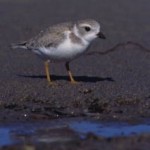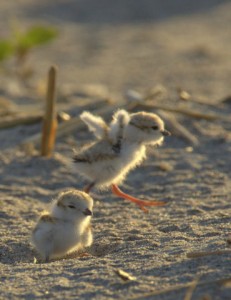It’s Better in the Bahamas – Part 1
The Search for Piping Plovers on their Wintering Grounds
By Todd Pover, Beach Nesting Bird Project Manager

One of the most frequently asked questions about piping plovers is, “where do they go in the winter?” In the most general sense, piping plovers that breed along the Atlantic Coast winter from North Carolina to Florida, along parts of the Gulf Coast, and on some Caribbean islands. Where our birds from New Jersey specifically spend the winter is largely unknown.
But research conducted over the past several years suggests that the Bahamas is a particularly important wintering site for piping plovers. Last winter under the auspices of Dr. Cheri Gratto-Trevor from Environment Canada, a total of 57 piping plovers were color banded in the Bahamas. All of the 41 banded piping plovers that were resighted on the breeding grounds last summer were found on sites along the Atlantic coast, including two that nested in New Jersey (Sandy Hook and North Brigantine Natural Area).
Every five years starting in 1991, the U.S. Geological Survey (USGS) has conducted an International Piping Plover Census, which includes both a breeding and wintering component. In 2001, just 35 piping plovers were reported in the Bahamas, although it was noted that there was not a coordinated effort to survey the islands that winter. In 2006, a total of 417 piping plovers were found in the Bahamas on the winter census, a significant increase that was attributed to a more intensive survey effort. Even at that, given that there are hundreds of islands and sand flats in the Bahamas, many of them difficult to access, it is believed even more piping plovers likely winter there.

This brings us to 2011, which is once again an international census year. The USGS, in association with the Bahamas National Trust and the National Audubon Society have made the Bahamas a high priority for this year’s winter census. Towards this end, a number of piping plover biologists and researchers that work on the breeding grounds in the U.S. and Canada were asked to assist with the Bahamas survey. The survey was conducted from January 24-February 6, and I was one of about a dozen or so members of the research team fortunate enough to help out.
The USGS has just begun to tally the survey results, but a rough preliminary tally indicates just over 1000 piping plovers being recorded in the Bahamas this winter, a significant increase over previous surveys. If most of those birds are from the Atlantic Coast population, as banding results suggest, at least a quarter of that population may winter in the Bahamas. By all accounts, it appears it very well may be “Better in The Bahamas” for our piping plovers!
Stay tuned. Over the next several weeks, I plan on penning more installments about my Bahamas piping plover adventure, including details about the surveys themselves, the logistical difficulties encountered, and the various local partnerships developed along the way.


